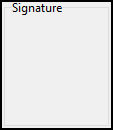OSD and POD
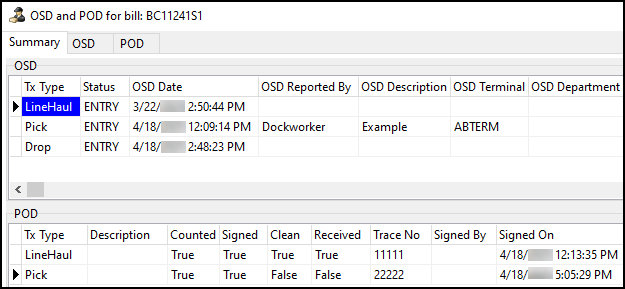
You can enter over, short, and damaged (OS&D) claims and record proofs of delivery (POD) in the OSD and POD window. While this functionality also exists in Customer Service, you can create OS&D and POD records without leaving Multi Mode Dispatch.
Setup
You can control which users can edit OSD and POD fields. This is done in Security Configuration under Security > Allow Changes. The security settings include:
-
Allow Edit of OS&D/POD Fields
Allows the user to enter and edit OSD and POD claims. If this option is not selected for a user, the OSD and POD window is read-only. -
Allow Edit of OS&D/POD Fields After the Freight Bill is Approved
Allows the user to edit OSD and POD fields after a freight bill has been approved. -
Allow Edit of OS&D/POD Fields After the Freight Bill is Posted to A/R
Allows the user to edit OSD and POD fields after a bill has been posted via the Billing Register.
Access the OSD and POD window
-
Select a trip. The trip’s details appear on the Trip Summary tab.
This option is not available for freight bills that are on a terminal stop or a waypoint stop.
-
Select the Freight Bills tab. A list of the trip’s freight bills opens.
-
Right-click a freight bill. The shortcut menu opens.
-
Go to Update Freight Bill(s) > Update OSD/POD. The OSD and POD window opens.
OSD
On the OSD tab you can create over, short, or damaged claims against a freight bill. You can enter multiple OSD records for a single freight bill.
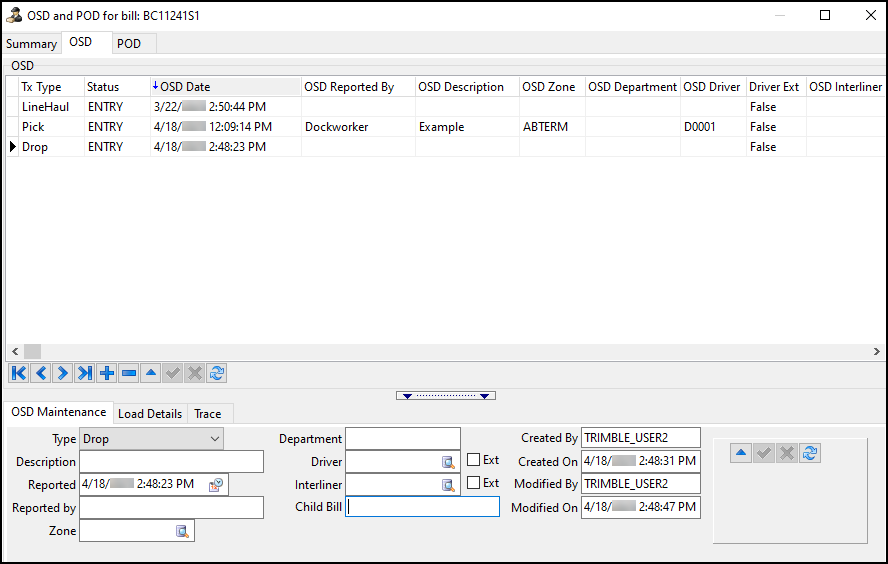
Create an OS&D record
-
Select
 Insert Record. An empty record appears on the OSD grid.
Insert Record. An empty record appears on the OSD grid. -
Select the Type dropdown and choose a claim type.
The claim type indicates when the issue was noticed:
-
Pick
The issue was noticed while goods were being loaded. -
LineHaul
The driver noticed damages during shipment. -
Drop
The issue was noticed at the delivery dock.
-
-
Select the Description field and enter a description of the issue.
-
Select the
 calendar next to the Reported field and set the date and time that the issue was reported.
calendar next to the Reported field and set the date and time that the issue was reported. -
Select the Reported By field and enter the name of the person who reported the issue.
-
Select the Zone field and enter the zone where the issue was noticed.
You can select the
 magnifying glass to look up a zone.
magnifying glass to look up a zone. -
(Optional) Select the Department field and enter a department name.
-
Select the Driver field and enter the driver’s name.
You can select the
 magnifying glass to look up a driver.
magnifying glass to look up a driver. -
Select the Ext checkbox next to the Driver field to mark the driver as external to your company.
-
(Optional) Select the Interliner field and enter an interliner.
You can select the
 magnifying glass to look up an interliner. To view the interliner’s full profile, right-click the field and select View in Vendor Profiles
magnifying glass to look up an interliner. To view the interliner’s full profile, right-click the field and select View in Vendor Profiles -
If the original bill is split, select the Child Bill field and enter the child bill number.
-
Select
 Post Edit to finish creating the record.
Post Edit to finish creating the record.
Load Details
You set whether the issue is over, short, or damaged on the OSD > Load Details tab.
-
Select an OSD record on the grid.
-
Select Load Details. The Load Details grid opens.
-
Select
 Insert Record. The OSD Detail Entry window opens.
Insert Record. The OSD Detail Entry window opens.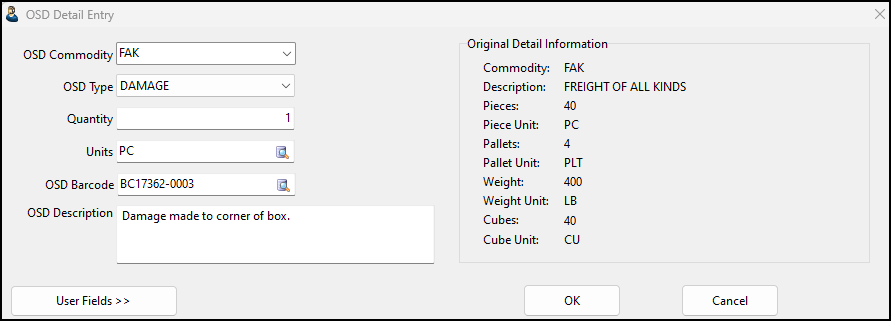
-
Select the OSD Type dropdown menu and choose a type:
-
DAMAGE
-
OVER
-
SHORT
-
-
Select the Quantity field and enter a quantity.
-
Select the Unit field and enter the unit type.
You can select the
 magnifying glass to look up a unit type.
magnifying glass to look up a unit type. -
If the claim is for a specific barcoded item, select the OSD Barcode field and enter the barcode.
If an entire shipment is affected, you can still enter a claim against an entire freight bill by not specifying a barcode. You can select the
 magnifying glass to look up a barcode.
magnifying glass to look up a barcode. -
Fill out any of your company-specific user fields:
-
Select User Fields. The list of user fields opens.
-
Select any field and enter a value.
-
-
Select OK. The OSD Detail Entry window closes and the Load Details grid updates.

| If you have configured Claim Types with Claim Type Rules, entering an OS&D record may automatically update the freight bill’s detail lines on the Details tab of Customer Service. See Claim Type Rules for more information. |
Trace
You can associate trace numbers with OSD records on the OSD > Trace tab.
-
Select a record on the OSD grid.
-
Select Trace. The Trace grid opens.
-
Select
 Insert Record below the Trace grid. A blank record appears on the grid.
Insert Record below the Trace grid. A blank record appears on the grid. -
Select the Trace Number field and enter a trace number.
-
Select the Quantity field and enter how many affected OSD items the trace number covers.
-
Select the Remark field and enter any remarks about the trace number.
-
Select
 Post Edit.
Post Edit.
POD
On the POD tab you can create proof of delivery records for a freight bill. All POD fields will be copied onto credits/rebills.
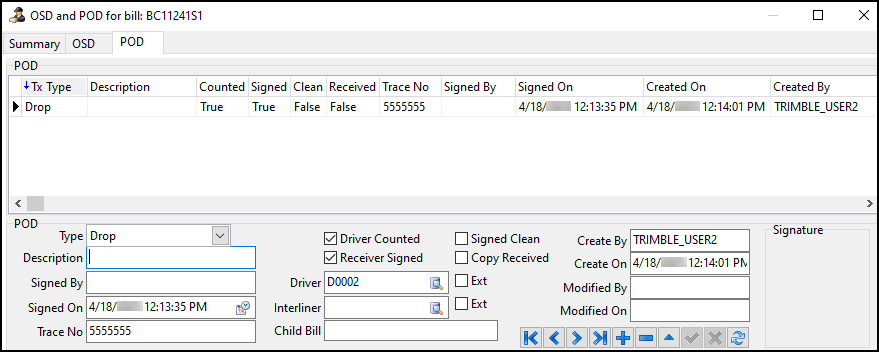
Create a proof of delivery record
-
Select
 Insert Record. A blank record appears on the POD grid.
Insert Record. A blank record appears on the POD grid. -
Select the Type dropdown menu and choose a type:
-
Pick
The proof of delivery was received while goods were being unloaded. -
LineHaul
The proof of delivery was received while the items were being unloaded. -
Drop
The proof of delivery was received when the items were delivered at the bill’s destination.
-
-
Select the Description field and enter a description of the proof of delivery.
-
Select the Signed By field and enter the name of the person who signed the proof of delivery.
-
Select the
 calendar next to the Signed On field to set the date and time that the proof of delivery was signed.
calendar next to the Signed On field to set the date and time that the proof of delivery was signed. -
If there is a trace number associated with the proof of delivery, enter it in the Trace No field.
-
Select the Driver Counted checkbox if the driver has made a notation on the bill of lading or delivery receipt indicating that they counted the freight as the shipment was unloaded from the trailer.
-
Select the Receiver Signed checkbox if the receiver’s signature came with notation that the shipping particulars and count agree with the bill of lading.
-
Select the Signed Clean checkbox if:
-
The shipment was signed "SLC".
-
There is a notation that the shipment was unloaded according to the bill of lading with no noted overages, shortages, or damages.
-
-
Select the Copy Received checkbox if a copy of the bill of lading for this shipment was received.
-
Select the Driver field and enter the driver’s name.
You can select the
 magnifying glass to look up a driver.
magnifying glass to look up a driver. -
Select the Ext checkbox next to the Driver field to mark the driver as external to your company.
-
(Optional) Select the Interliner field and enter the interliner.
You can select the
 magnifying glass to look up an interliner. To view the interliner’s full profile, right-click the field and select View in Vendor Profiles.
magnifying glass to look up an interliner. To view the interliner’s full profile, right-click the field and select View in Vendor Profiles. -
Select the Ext checkbox next to the Interliner field to mark the interliner as external to your company.
-
If the original bill is split, select the Child Bill field and enter the child bill number.
-
Select
 Post Edit to finish creating the record.
Post Edit to finish creating the record.
